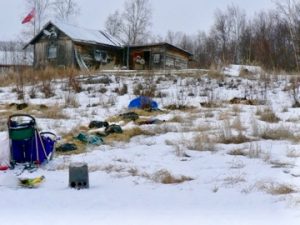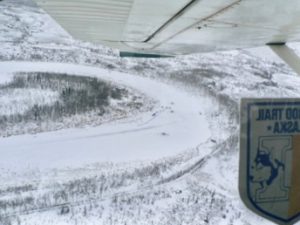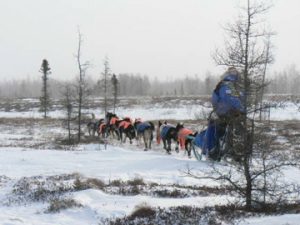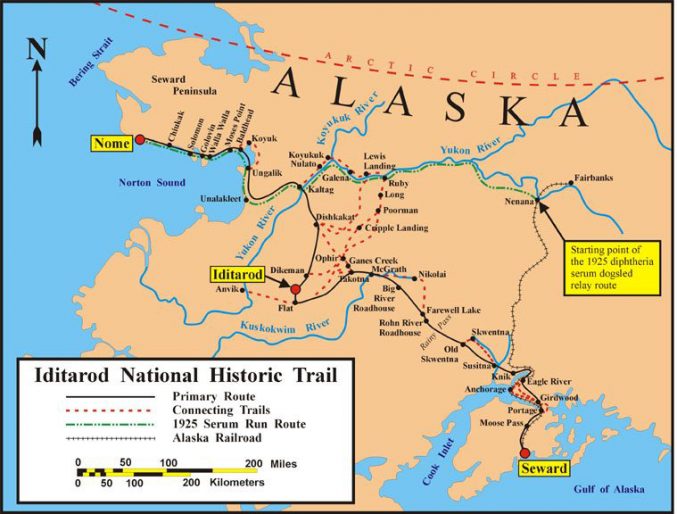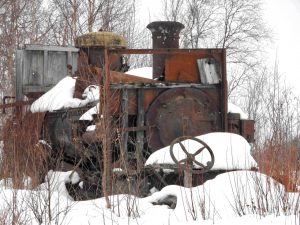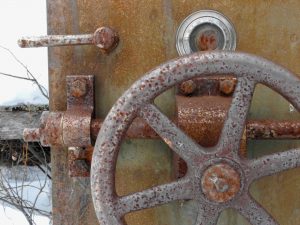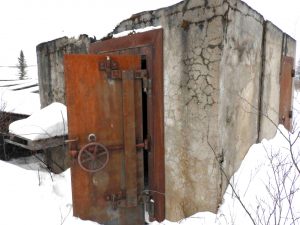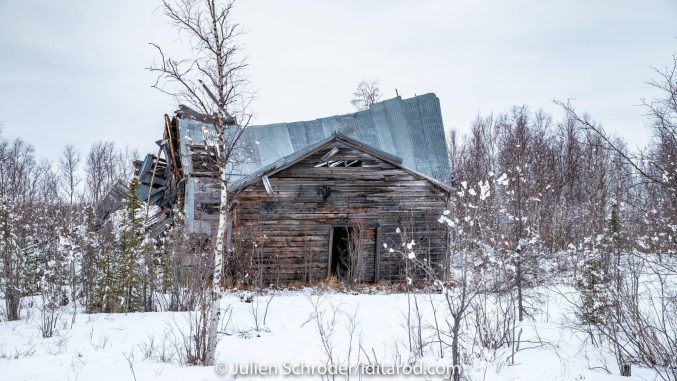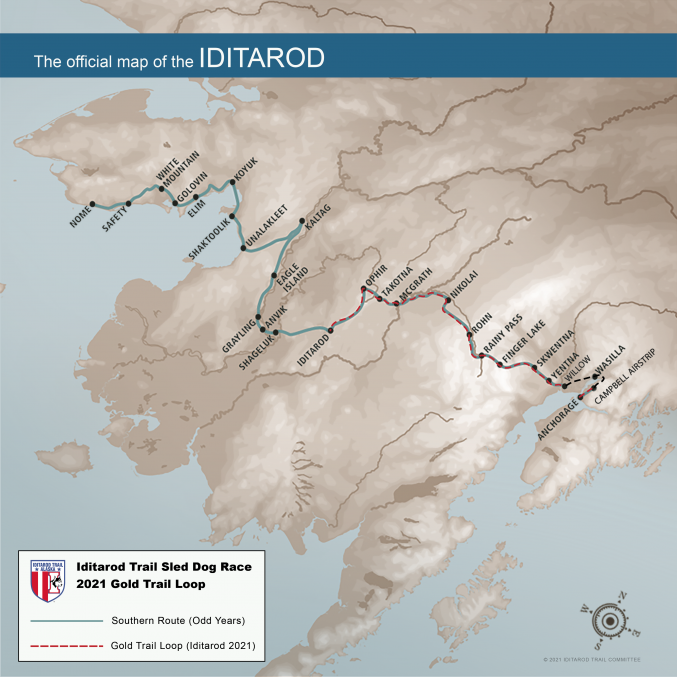- Old Building at Iditarod – photo K. Slade
- Bend of Iditarod River – photo K. Slade
- Martin Buser near Iditarod – photo K. Slade
Have you ever wondered where the word or name Iditarod came from? I’ve heard 3 explanations. First, Iditarod was a word used by Athabascans that meant FAR DISTANT PLACE. Second, Iditarod was a word from another indigenous language that meant CLEAR WATER. Finally, a ROD is a measure of distance and so one miner might ask another, “How’d you do today?” The miner would answer, “I-DID-A-ROD.” The most commonly accepted meaning is “Far Distant Place.”
Six miles out of Ophir it’s CRITICAL to know if it’s an odd or even year although the trail will be clearly marked. In odd years, teams go left at the fork in the trail, taking the “southern” route but in even years, teams fork right and travel along the “northern” route. Are you wondering why there are two routes?
Iditarod is a SIGNIFICANT event that requires a MONUMENTAL amount of work but provides ENORMOUS excitement in the everlasting winter for the people of interior Alaska. It’s a wise choice for the small interior villages along the alternate year routes to divide the work and share the excitement.
The trail that Iditarod mushers take to Nome doesn’t exactly follow the Iditarod National Historic Trail of the early 1900s. The primary Iditarod National Historic Trail left Takotna, and dropped southwest to Flat. Then the trail headed north through Iditarod, Dikeman and Dishkakat before veering northwest to Kaltag. There were also connecting trails that went northwest out of Takotna to Ophir then Dishkakat. If a straight line were drawn from Ophir to Kaltag, Dishkakat would be about in the middle.
The Iditarod Historic Trail Alliance has created several excellent resources. One is a video describing the trails and how they came to be. The map shown above is included in this story by permission of the Iditarod Historic Trail Alliance. These resources and others found at www.iditarod100.org provide information to help us understand the trail system Joe Redington sought to preserve in establishing the Iditarod Trail Sled Dog Race.
Have you ever considered why they don’t run the Iditarod race straight over to Kaltag from Ophir? Such a route would very closely follow the Iditarod Historic Trail of the early 1900’s. Can you come up with a mileage for that “straight shot?” There in lies the answer to the question. Taking the “straight shot” from Ophir to Kaltag would shorten the race considerably.
Hudson Stuck, Archdeacon of the Yukon, traveled by dog team and riverboat to serve outpost churches located in mining towns during the gold rush. The Episcopal priest referred to the country between Ophir and Kaltag where Dishkakat was located as the most God-forsaken place on earth.
Perhaps early race organizers were influenced by Stuck’s opinion but more likely it was their desire to stage a 1,000-mile race that determined the route of Iditarod. Deciding to send the racers on a northern route through Ruby and later establishing a southern route through Shageluk and Anvik gave them an impressive, challenging yet obtainable 1,000 miles, utilized established villages as checkpoints and avoided the desolate land between Ophir and Kaltag.
The 80 miles of trail between Ophir and Iditarod has many large spruce, birch and cottonwood trees. There’s not much change in elevation as mushers traverse frozen creeks, swamps and lakes as well as tundra on the way to once thriving Iditarod. In low snow years, the tussocks on this part of the trail are as punishing for the mushers as those of the Farewell Burn.
Gold was discovered on Christmas Day of 1908 near Flat, a short distance from the Iditarod River. News traveled and those seeking riches and adventure found their way either by land on the frozen Iditarod Trail or by river on steamers. The discovery of gold near Flat launched Iditarod as a mining camp, supply station and fashionable city.
- Steam Powered Tractor (Photo Credit: D. Olmstead)
- Combination Lock – photo D. Olmstead
- 2 foot thick Cement Walls – Photo D. Olmstead
During high water times, steamers could navigate to Iditarod located at the bend of the river but not farther. It therefore became the supply depot for the nearby mines of Flat, Otter Creek and Dikeman. By 1910, the “camp” became a well-appointed city, as did Flat. The folks living in the two boomtowns enjoyed the convenience of gaslights, telephones, newspapers, banks, restaurants, hotels, post office, pool hall, and school. Flat was 8 miles from Iditarod, just far enough that a horse-drawn tramway was built connecting the communities. Back in the day, Iditarod and Flat were known as the Twin Cities.
Some of the buildings in Iditarod’s sister city, Flat, have survived the test of time and nature. Buildings standing tall more than 100 years after the discovery of gold in the area include a mercantile, the school with desks and the town hall with a piano. Bush pilots who land to explore the area use a runway created when miners smoothed out mounds of tailings. In 2015 bush pilot, Kevin Doyle, flew out to Flat and captured video of the long abandoned town. Thanks to Doyle’s work posted on YouTube, viewers can get a virtual sense of Flat. Along with the remaining buildings, there’s a gold dredge, some trucks and other mechanical relics spread about the landscape as testament to the once prosperous mines.
Except for one trapper, nobody has lived in Iditarod since around 1940. Like the miners, the trapper has also moved on. Besides the trapper’s house there is a bank vault with two-foot thick cement walls, some abandoned mining equipment and a few other dilapidated buildings that still remain. The Iditarod post office closed in 1925.
More recently, a family of five lived in Flat year round to maintain the equipment for summer mining operations. When they departed in 2004, the Flat post office, zip code 99584, closed.
June Allen published a story in the March 2005 edition of the SitNews describing the early trail and its purpose. Allen called the sub-Arctic trail system Alaska’s earliest expressway. What began as a trail connecting native villages evolved with time and necessity into a supply route connecting mining camps that sprang up during the gold rush. That’s when the trail took on the “Iditarod” name.
The Iditarod strike turned out to be the last great hurrah of Alaska’s gold rush. The mines were depleted within a few years and the miners left but not before $33 million dollars of gold had been mined. The first official census figure for the Iditarod area wasn’t reported until 1920 when the gold was depleted and miners had moved on. It’s only a best guess as to how many people actually inhabited Flat and Iditarod during the boom years just before and after 1910 but judging by the development, it’s fair to say it was a healthy number. Today with a population of zero for both Flat and Iditarod it’s for sure a lonely deserted place that returns to life once every two years during the activity of Iditarod.
With a picture being worth a thousand words, I extend thanks to Insider crewmember Dorothy Olmstead, 2007 Teacher on the Trail Kim Slade and photographer Julian Schroeder for their photos that help bring the ghost town of Iditarod to life for today’s race fans.
Do you suppose the mushers, dogs and volunteers can feel the “spirits” of the departed miners as they pass through the ghost towns of Iditarod and Flat? That’ll be a question for the mushers, volunteers and race officials after they experience the Iditarod Gold Trail Loop of 2021.




